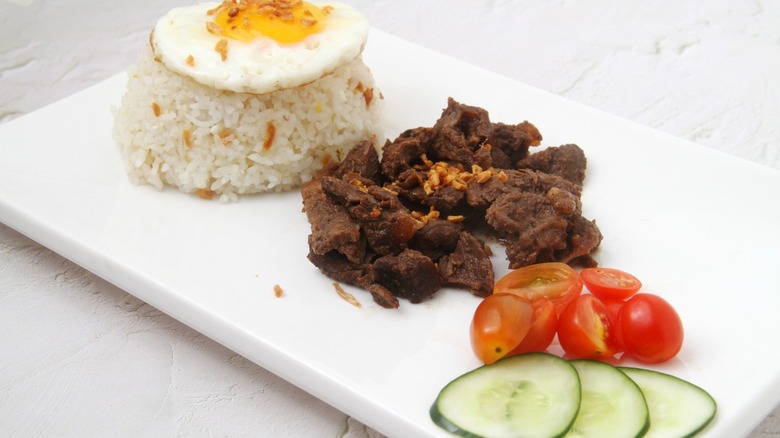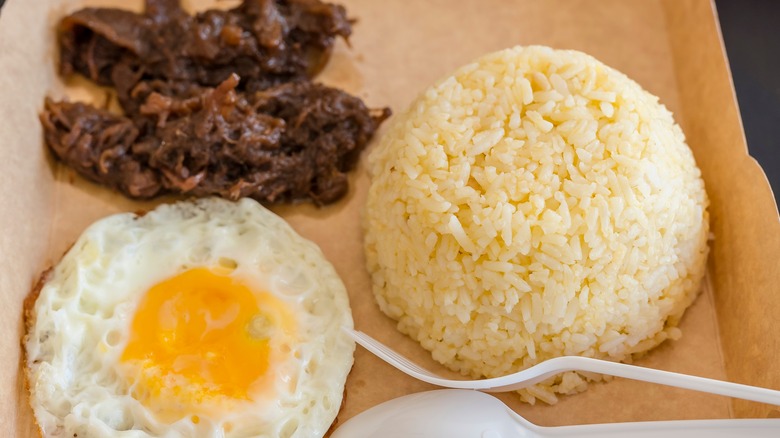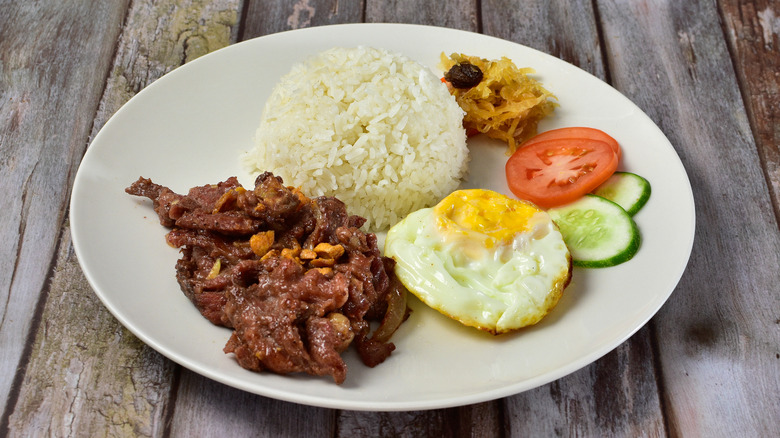Filipino Tapsilog Is A Crispier Take On Steak And Eggs
Food history is full of stories of dishes that began as meals meant to fill the belly instead of tickle the palate. For example, according to The New York Times Style Magazine, many of the ingredients we enjoy today, from caviar to tougher cuts of beef, were once considered "delicacies of the poor," as they were deemed undesirable by the upper class. However, those who relied on these foods for survival learned to create recipes highlighting their unique, delicious flavors, turning them into the now-revered meals of today, such as boeuf bourguignon. This was also the case with one of the Philippines' most loved breakfast dishes: "tapsilog."
The meal comes with marinated slices of beef, "tapa," fried until brown and slightly crisp, a fried egg, and a generous serving of garlic fried rice. It's served with a vinegar dipping sauce for the meat, per Panlasang Pinoy. And while it may not look like much, tapsilog, in one form or another, has satisfied bellies across the country. Esquire points out that not all tapsilog is made with beef, though, because it can also be made with mutton or horse, carabao, or goat meat.
Tapsilog has humble beginnings
Esquire tracks the origins of tapsilog to a street canteen owned and operated by Vivian Del Rosario. She opened her cheap and cheerful eatery on a Metro Manila street corner in 1986 with one market in mind: public transportation drivers and other hungry bellies with a limited budget. The name of her store: "Tapsi ni Vivian at Bulaluhan," or "Vivian's Tapsi and Bulalo Stand." Bulalo is a classic Filipino beef marrow soup, per No Recipes.
There wasn't much money to be had; Del Rosario had a daily working capital of about 1,000 Philippine pesos, or about $49, based on the exchange rates of the time, per the University of British Columbia. But with that, she was able to pull together what would become a bestseller — tapa (cured or marinated meat), sinangag (garlic rice), and fried itlog (egg). She named the dish "tapsilog" by blending the names of its three key components.
And that's not the only thing Del Rosario came up with. Esquire quotes the enterprising food stall owner as saying: "We also came up with tocilog — tocino [or sweet cured pork], sinangag, [and] itlog."
Today, del Rosario's street stall has evolved into a modest restaurant chain, per Facebook.
Tapsilog is easy to make and assemble
While getting to Del Rosario's stand to try the original tapsilog may be a bit of a challenge, it might be good to know that the Philippines' version of steak and eggs is easily replicated at home. Bon Appétit recommends using thinly sliced pieces of sirloin so you can get the meat to crisp up as it should and to coarsely chop the garlic, which is meant to go into the beef marinade made with sugar, soy sauce, vinegar, pepper flakes, and salt. Panlasang Pinoy prepares the egg in nearly a sunny-side-up manner, covering the pan and letting the steam cook the eggs instead of solely frying, and makes the sinangag using leftover rice and crushed garlic. When serving, Bon Appétit suggests adding a side of sliced tomato, pickled papaya, known as "atchara," and vinegar.
If steak and eggs aren't your thing, there are other ways to enjoy the garlic rice and egg combination. According to Esquire, Filipino variations of the classic dish include bangsilog, made with milkfish or bangus, and Spamsilog, made with Spam. Further variations of garlic rice and egg feature corned beef ("cornsilog"), adobo ("adosilog"), and the Philippine sausage known as longanisa ("longsilog").


